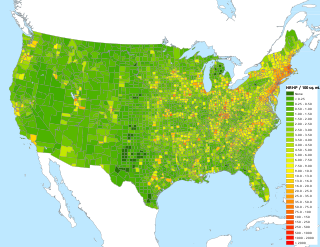
The National Register of Historic Places in the United States is a register including buildings, sites, structures, districts, and objects. The Register automatically includes all National Historic Landmarks as well as all historic areas administered by the U.S. National Park Service. Since its introduction in 1966, more than 97,000 separate listings have been added to the register.

Here is presented a listing of the National Register of Historic Places in Black Hawk County, Iowa.

This is a list of the National Register of Historic Places listings in Poweshiek County, Iowa.
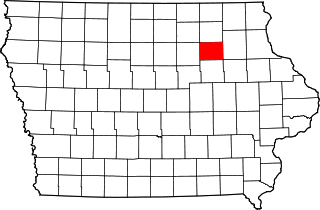
This is a list of the National Register of Historic Places listings in Bremer County, Iowa.

The LeClaire Park Bandshell, also known as the W.D. Petersen Memorial Music Pavilion, is located on Beiderbecke Drive in LeClaire Park, Davenport, Iowa. It was listed on the National Register of Historic Places in 1983 and on the Davenport Register of Historic Properties in 1993.

The Warner Apartment Building was a historic building located on the east side of Davenport, Iowa, United States. Dr. Fay L. Warner, a dentist, had the structure built in 1900 and lived here himself until 1908. A relative of his, Fred Warner, lived here in later years and managed the building. The three-story brick structure was one of the most distinguished apartment blocks in Davenport. The building featured a picturesque façade that was typical of Victorian era architecture. The round arch entrances were below ogee-arched moldings. At the top was a deep corbelled cornice frieze. The five sections of the main façade were articulated by full-height octagonal bays. The building was also banded by flat and projecting string courses. The structure was on a raised lot and had a low, stone retaining wall at the sidewalk. It was listed on the National Register of Historic Places in 1983, and has subsequently been demolished.
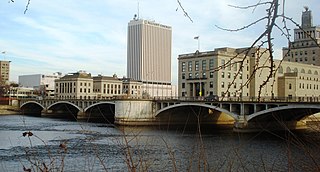
The First Avenue Bridge is a historic structure located in downtown Cedar Rapids, Iowa, United States. It carries U.S. Route 151 for 697 feet (212 m) over the Cedar River. The original six-span concrete arch structure was completed in 1920 for $420,000. It was designed by Marsh Engineering Company and built by Koss Construction Co., both of Des Moines. Consulting engineer Ned L. Ashton of Iowa City designed the 1960s remodel. He had all of the concrete work above the original arches torn out and the bridge rebuilt as an open-spandrel structure. The rebuild also included a wider deck to accommodate increased traffic and aluminum railings. While the bridge's original structural integrity has been compromised, this is the first notable concrete spandrel arch reconstruction in Iowa and possibly in the country. The bridge was listed on the National Register of Historic Places in 1998.
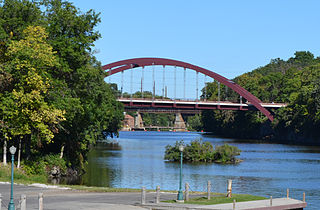
The Iowa Falls Bridge, also known as the Oak Street Bridge, was a historic structure located in Iowa Falls, Iowa, United States. The span carried U.S. Route 65 over the Iowa River for 255 feet (78 m). The through arch bridge was built by the Weldon Brothers Construction Co. of Iowa Falls in 1928 for $51,374.98. At the time it was completed the bridge was the longest arch span in the state of Iowa. It was listed on the National Register of Historic Places in 1998. The historic bridge was demolished and replaced in 2010.

The Washington Avenue Bridge in Iowa Falls, Iowa is an attractive concrete two-span open spandrel arched bridge that brings Washington Avenue over the Iowa River. Originally it carried US 20. It was built in 1934 by the Weldon Brothers for $51,710.55.
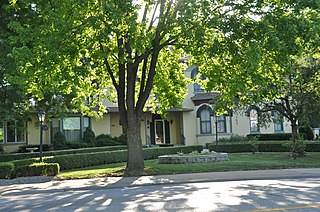
W. Joseph Fuller House is a historic residence located in Muscatine, Iowa, United States. It has been listed on the National Register of Historic Places since 1982.
The Green Mill Ford Bridge was a historic structure located northeast of Janesville, Iowa, United States. It spanned the Cedar River for 244 feet (74 m). This Bowstring through arch-truss bridge was originally erected in Waverly, Iowa after the Bremer County Board of Supervisors found the previous timber structure bridge was worn out. It was designed and erected by the King Iron Bridge and Manufacturing Co. of Cleveland. John R. Price and Brothers built the substructure. The total cost for constructing the bridge was $16,000. It remained in service at this location until 1898 when it was replaced by a girder bridge. The bow string trusses were dismantled three years later. One of the spans was erected over the Cedar River in Franklin Township, while the remaining two spans were erected here in Jefferson Township. The Green Mill Ford Bridge was closed to traffic in 1988. The bridge was listed on the National Register of Historic Places (NRHP) in 1998.
The Little Sioux River Bridge is a historic structure located northwest of Spencer, Iowa, United States. It spans the Little Sioux River for 180 feet (55 m). The bridge was originally located at Main Street, south of downtown Spencer over the same river. Two previous bridges had been located at the original location beginning in 1875, with a replacement in 1889. Clay County contracted with Clinton Bridge and Iron Works from Clinton, Iowa in 1900 to build this Pennsylvania through truss span. Completed the following year, it is the rare example of this type of bridge built in Iowa. A concrete arch span replaced this bridge in 1915, and it was moved to its current location the same year. The concrete abutments were built by Thor Construction Company from Cedar Falls, Iowa. The bridge was listed on the National Register of Historic Places in 1998.
The James Newell Barn was a historic building located north of Cedar Falls, Iowa, United States. Newell was the first settler in Washington Township. The Ohio native settled here in 1845 from Louisa County, Iowa. The area is called Turkey Foot Forks, named by Native Americans because the confluence of the Shell Rock River and the Cedar River looks like the foot of a wild turkey. The two-story structure with a gable roof was built on a native limestone foundation. Black walnut timber from the property was used in the construction. It was listed on the National Register of Historic Places in 1976. It was removed in 2022.
The Rock Falls Bridge is a historic structure located in Rock Falls, in the north-central part of the U.S. state of Iowa. The span carries Spring Street over the Shell Rock River for 142 feet (43 m). The Iowa State Highway Commission prepared the plans for this bridge in September 1928, and they were revised in February 1929. While they designed riveted steel trusses for medium-span bridges in rural areas, they used concrete open spandrel arches like this one for several urban and small town structures in the 1920s. C.A. Holvik of Mason City was awarded the contract to construct the bridge, which they completed later in 1929. It was listed on the National Register of Historic Places in 1998.
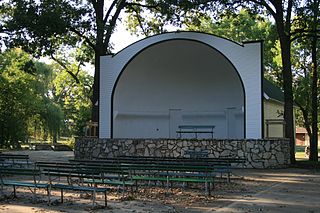
The East Park Band Shell is a historic structure located in Mason City, Iowa, United States. The band shell was individually listed on the National Register of Historic Places in 2009. In 2014 it was included as a contributing property in the East Park Historic District.

The Grandview Park Music Pavilion is a historic structure located in Sioux City, Iowa, United States. The Monahan Post Band raised money in 1930 to build a modest music shell in the park. Construction was already underway when the park's neighbors objected to the design. The project was put on hold as the band raised more money and sought a more suitable design. After President Franklin D. Roosevelt created the Civil Works Administration (CWA) in 1933, the city applied to have the new music shell included in Sioux City's projects. Henry L. Kamphoefner, an unknown Sioux City architect at that time, drew up the plans for the structure. The sculptural plaques on the front of the pavilion were designed by Herschel Elarth. The CWA approved the project on February 26, 1934, as CWA Project Number 217. The construction project required 52 tons of reinforcing steel, 4,200 bags of Portland cement, and 300 bags of white cement, and it was completed on October 17, 1934. Seating was constructed for 5,000 in the natural amphitheater. The pavilion was built using $47,436 from Federal Relief funds and $3,800 in materials from the city. It was dedicated in the spring of 1935. The Monahan Post Band continued to play here until 1948, when they became the Sioux City Municipal Band. They continue the summer-time tradition. The music pavilion was listed on the National Register of Historic Places in 2011.

Bandshell Park, also known as City Park and Music Pavilion, is located in Ames, Iowa, United States. It is a nationally recognized historic district that was listed on the National Register of Historic Places in 1999. At the time of its nomination it consisted of six resources, which included one contributing building, one contributing site, two contributing structures, one contributing object, and one non-contributing object. The park, located to the east of the central business district, was gift to the city in 1884 from the C&NW Land Company. The full city block was the first park established in Ames.
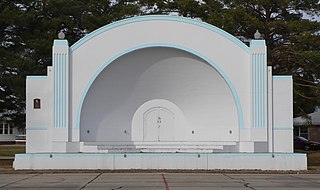
The Athletic Park Band Shell in Plainview, Nebraska was designed and built during 1939 to 1942. Also known as Plainview Band Shell, it was listed on the National Register of Historic Places in 1992.

The old Cedar Falls Post Office is an historic building located in Cedar Falls, Iowa, United States. Completed in 1918, this was the city's first federal government building, and Black Hawk County became the only county in the state with two post offices that reported directly to the United States Post Office Department. It was built at the time when the design of federal building's were controlled by the Department of the Treasury. This building was designed by James A. Wetmore, who was the Acting Supervising Architect of the U.S. Office of the Supervising Architect. It was built by Des Moines contractor Frederick C. Weitz. The single-story Neoclassical brick structure features a symmetrical facade, a slightly recessed central bay, a round-arched entryway flanked by round arched windows, and Bedford stone trim.

This is a list of the National Register of Historic Places listings in Des Moines, Iowa.



















